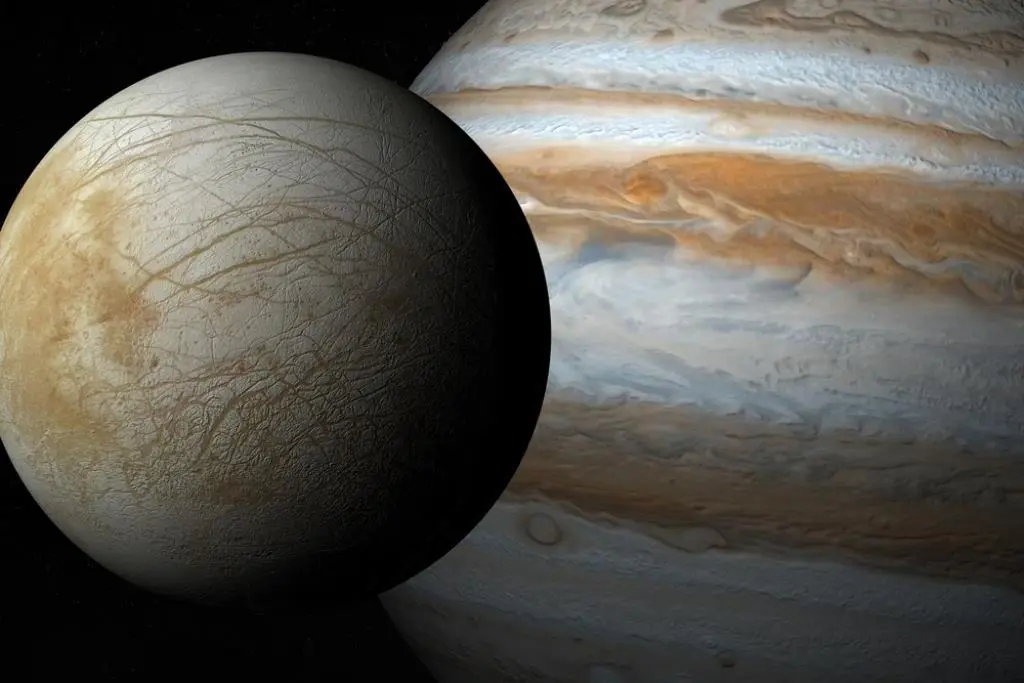Perhaps Jupiter's most interesting moon is Europa, whose surface marks suggest that the icy crust is at the mercy of the massive water mass beneath.
A recent visit by Juno detected jet activity on the mantle, which, if real, would allow future missions to sample the inner ocean without landing.
source: Depositimages.com
Strange things happen on Jupiter's moons
It has been nearly two years since Juno made its closest approach to Europa, but its observations are still being analysed.
Although it has been orbiting Jupiter since 2016, the five images taken by Juno on September 29, 2022, were the first close-ups of Europa since the last visit by the Galileo spacecraft in 2000.
Europa is the smoothest body in the solar system, as its inner circumference often rises to the surface. However, he is not a boring moon with similar hair.
Juno observed some steep depressions and fractures 20 to 50 kilometers wide, which are believed to be traces of polar migration.
“True polar migration occurs when Europe's icy crust separates from its rocky interior, resulting in high pressure and predictable fracture patterns on the crust.”
Dr. Candy Hansen of the Planetary Science Institute said in a statement.
The idea behind true polar migration is that the mantle that rests over Europa's inner ocean rotates at a different speed than the rest of the moon.
It is believed that the movement of the water beneath it pulls on the shell, and currents within the ocean affect the movement of the shell.

Jupiter's icy moon Europa. Source: Flickr
Europa is Jupiter's stress ball
On the other hand, the currents are supposed to be driven by heating in Europa's rocky core, where the gravitational pull of Jupiter and the larger moons creates enormous tension in Europa.
In the process, interactions between ocean and ice can stretch and compress areas, creating the cracks and ridges seen since Voyager 2's visit.
“This is the first time such fault patterns have been mapped in the Southern Hemisphere, suggesting that the impact of true polar migration on Europe's surface geology is more extensive than previously identified.”
Not all changes in the map of Europe are the result of internal ocean currents. Even NASA seems to fall for optical illusions.
“Gwerne Crater no longer exists. What was previously thought to be a 21-kilometre-wide impact crater – one of the few documented impact craters in Europe – was revealed by JunoCam data as a series of intersecting ridges that created an oval shadow.
Is Europe a platypus?
However, the team's interest was piqued by something they call the duck-billed platypus because of its shape.
The ridge formations on its edge appear to be collapsing, which may be due to cavities filled with salt water partially penetrating the ice sheet. Oddly shaped pictures are IFLScience Can be viewed on
Such pockets would be interesting and indirect targets to study, but even more interesting are the dark patches that may have been deposited during cryovolcanic activity.
“These features indicate present-day surface activity and the presence of liquid water beneath Europa's surface,” said Heidi Becker of JPL.
Enceladus hot springs have confirmed the presence of such activity, but it is not known if it is still occurring in Europe.
Such an activity would allow us to sample the inner ocean for signs of life, simply by flying through a plume and collecting a few flakes of ice, without having to land, let alone dig.
Polar migration cannot yet modify the surface of Europa to any great extent, but there is evidence that it shifted more than 70 degrees millions of years ago, for reasons that remain unknown.
Worth reading:












































